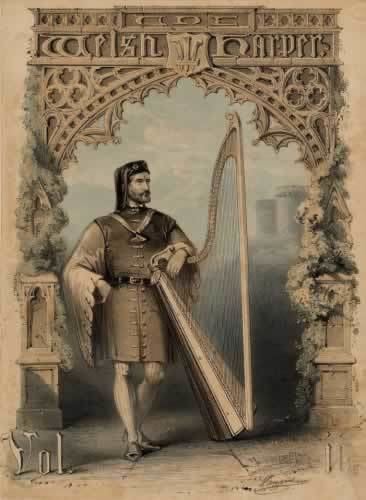 | ||
"The Wind" (Welsh: Y Gwynt) is a 64-line love poem in the form of a cywydd by the 14th-century Welsh poet Dafydd ap Gwilym. Dafydd is widely seen as the greatest of the Welsh poets, and this is one of his most highly praised works. Rachel Bromwich called it "one of the greatest of all his poems", while the academic critic Andrew Breeze has hailed it as "a masterpiece" and "a work of genius", noting especially its "rhetorical splendour".
Contents
Summary
The poet opens by addressing the wind, calling it a strange being, going where it wills, and subject to none of the physical or legal restraints of ordinary human life. After praising it for its power the poet goes on to compare it to an author, a sower of leaves, and a jester. Then he asks the wind to visit Uwch Aeron [the northern part of Ceredigion, from where Dafydd came], and, paying no heed to her husband Bwa Bach to visit the poet's lover Morfudd, on whose account he is an exile from his native land. The wind is to send the poet's sighs to Morfudd, to assure her of his continued love, and to return safely.
Poetic art
"The Wind" is one of the classic examples of the use of what has been called "a guessing game technique" or "riddling", a technique known in Welsh as dyfalu comprising the stringing together of imaginative and hyperbolic similes and metaphors. Sometimes Dafydd used dyfalu pejoratively; less often, as in this poem, to express his wonder at one of the great forces of nature. The display of Dafydd's virtuosity in this technique has been seen as his prime motivation for writing the poem.
Lines 9–24 of the poem all begin with the letter N, and in the succeeding 14 lines a similar use is made of the letters R, S, D, and finally H. Dafydd took this poetic device, known as cymeriad, from the older poetic form of awdl, a kind of poem much used by court poets of the preceding centuries for poems of praise addressed to their patrons. He employed it in several of his cywyddau.
Genre and themes
"The Wind" is cast in a form closely associated with Dafydd, the poem in which a messenger or llatai, usually a bird or animal, is sent to the poet's lover. It is a good example of how Dafydd's works in this form can include a close and warmly-appreciative description of a llatai, even when, as is often the case in Dafydd's poems, he is describing nature in one of its harsher aspects. The careering course of the wind is embodied in the headlong pace of the poem. Rachel Bromwich called "The Wind" one of "the outstanding expressions of Dafydd's wonder and awe at the mysteries of the cosmic forces", but pointed out that in the end Dafydd curbs this force to act as a love-messenger to Morfudd. The poet Gwyneth Lewis sees the poem as "a hymn to the havoc that art can work in the world", while for the scholar Helen Fulton the wind is a metaphor for "freedom and autonomy from the laws of governing society". This political aspect of the poem is particularly apparent in lines 19–22 (13–16 in some editions):
…though you winnow leaves
no one indicts you, you are not restrained
by any swift troop, nor officer's hand
nor blue blade…
This has been interpreted as an implicit comparison with the king's official messengers, who were immune from legal consequences should they trample their way through standing crops in the line of duty. Andrew Breeze finds in these same lines a reminder that Dafydd was living in a land occupied by foreigners. On the other hand, for Anthony Conran the freedom celebrated in the poem is an essentially personal one, the expression of his own ungovernable character. Likewise Richard Morgan Loomis sees the wind as Dafydd's "glorious alter-ego", the poem being "the paradoxical fantasy of a frustration that would speak through an uncontrollable freedom".
